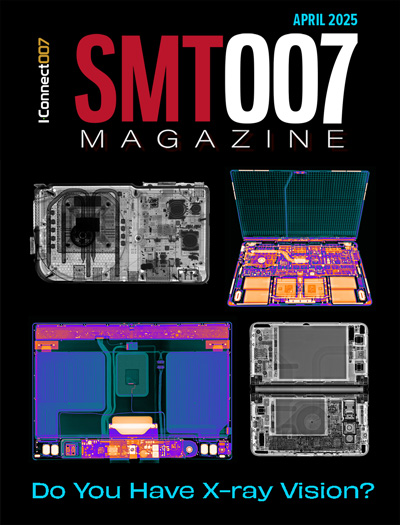-

- News
- Books
Featured Books
- smt007 Magazine
Latest Issues
Current Issue
Do You Have X-ray Vision?
Has X-ray’s time finally come in electronics manufacturing? Join us in this issue of SMT007 Magazine, where we answer this question and others to bring more efficiency to your bottom line.

IPC APEX EXPO 2025: A Preview
It’s that time again. If you’re going to Anaheim for IPC APEX EXPO 2025, we’ll see you there. In the meantime, consider this issue of SMT007 Magazine to be your golden ticket to planning the show.

Technical Resources
Key industry organizations–all with knowledge sharing as a part of their mission–share their technical repositories in this issue of SMT007 Magazine. Where can you find information critical to your work? Odds are, right here.
- Articles
- Columns
Search Console
- Links
- Media kit
||| MENU - smt007 Magazine
DARPA Collaborates with UK and Canadian Government Partners in Agency’s First Trilateral Project
September 23, 2024 | DARPAEstimated reading time: 3 minutes
DARPA, the Canadian Department of National Defence, and the U.K. Ministry of Defence will collaboratively pursue research, development, test, and evaluation technologies for artificial intelligence (AI), cyber, resilient systems, and information domain-related technologies.
The rapid pace of technology development has made expanding and codifying this trilateral partnership essential to meeting future challenges in an ever-changing geopolitical environment. This effort will further leverage relevant research programs among all nations and reduce duplication of efforts.
In addition to strengthening international partnerships, DARPA’s goal is to continue reducing technological risks so new capabilities can transition into operational use as quickly as possible. One research project already underway in the collaboration is the Cyber Agents for Security Testing and Learning Environments (CASTLE) program, which trains AI to autonomously defend networks against advanced persistent cyber threats. Other research and development areas of interest include defining and creating trustworthy AI systems, even in the face of attacks by skilled, high-resource adversaries; protecting, detecting attacks on, and measuring the health of the information domain; and producing tools and techniques that result in more resilient and secure systems, such as rapid certification of software.
In another example, researchers are cooperating to develop interoperable defensive cyber capabilities. As malicious actors use artificial intelligence to increase the pace and volume of cyber attacks, human operators alone cannot keep up. Test beds that simulate a network architecture will be developed to enable artificial-intelligence defensive software to quickly assess, categorize, and generate a response to cyber threats, enabling cyber operators to rapidly make decisions to defend against malicious attacks.
DARPA convened a symposium over the summer of 2024, which included representatives from across the U.K. and Canadian governments, the U.S. Executive Office of the President’s National Security Council and Office of Science and Technology Policy (OSTP), the U.S. State Department, the U.S. Department of Energy, and the Advanced Research Projects Agency – Health to begin planning collaborative efforts.
The Ministry of Defence’s Defence Science and Technology Laboratory (Dstl) will be the lead agency for the U.K. and the Department of National Defence’s science and technology organization, the Defence Research and Development Canada (DRDC), will be the lead organization on behalf of Canada.
Dr. Nick Joad, Director Science and Technology at the U.K. Ministry of Defence, said:
“Our international research collaborations with both the U.S. and Canada are some of our most vital and enduring partnerships. This agreement cements our collective commitments to advancing emerging cyber security technologies such as cybersecurity and artificial intelligence to enhance the defence and security of our nations.”
Dstl Chief Executive, Dr. Paul Hollinshead, said: “This partnership with two of our closest allies will help keep the U.K. secure at home and strong abroad today and in the future. Together, we are driving value for money for our respective taxpayers while creating mission critical capabilities through science and technology, keeping our countries and our people safe.”
DRDC Assistant Deputy Minister, Dr. Jaspinder Komal, said: “Due to the pervasive nature and rapid evolution of artificial intelligence in dual-use technologies with civilian and military applications, we’ve identified this as a priority area for defence research. We’re pleased to be working with our allies in the U.K. and U.S. through this trilateral agreement, which will potentially enable a multitude of cooperative research projects in the cyber and information domains.
DARPA Director, Dr. Stefanie Tompkins, said: “We know we're stronger together than separately. The trilateral collaboration is a big step toward enhancing our understanding in the outlined R&D thrust areas. Working with our international partners on science and technology helps us all leverage each other’s individual strengths in order to develop much greater collective capability.”
Suggested Items
BrainChip Partners with RTX’s Raytheon for AFRL Radar Contract
04/03/2025 | BUSINESS WIREBrainChip Holdings Ltd, the world’s first commercial producer of ultra-low power, fully digital, event-based, neuromorphic AI, today announced that it is partnering with Raytheon Company, an RTX business, to service a contract for $1.8M from the Air Force Research Laboratory on neuromorphic radar signaling.
Qualcomm Expands Generative AI Capabilities With Acquisition of VinAI Division
04/03/2025 | Qualcomm Technologies, Inc.Qualcomm announced the acquisition of MovianAI Artificial Intelligence (AI) Application and Research JSC (MovianAI), the former generative AI division of VinAI Application and Research JSC (VinAI) and a part of the Vingroup ecosystem.
Qualcomm Expands Generative AI Capabilities With Acquisition of VinAI Division
04/02/2025 | Qualcomm Technologies, Inc.Qualcomm announced the acquisition of MovianAI Artificial Intelligence (AI) Application and Research JSC (MovianAI), the former generative AI division of VinAI Application and Research JSC (VinAI) and a part of the Vingroup ecosystem.
IDC Predicts AI Solutions & Services will Generate Global Impact of $22.3 Trillion by 2030
04/02/2025 | IDCIDC, the global leader in trusted technology intelligence, has today released a comprehensive analysis highlighting the profound economic impact of artificial intelligence (AI) on the global economy, at its IDC Directions event — which focuses on the pivotal role AI plays in today's business landscape.
LiU and Siemens Energy Enter Into Strategic Partnership
04/01/2025 | Linköping UniversityIn order to find long-term solutions to future challenges in the energy field, Linköping University and Siemens Energy AB sign a strategic partnership agreement.


